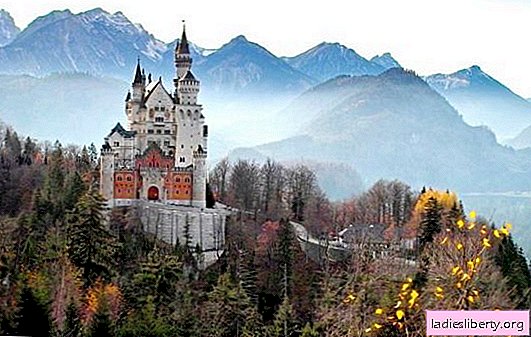
Those of you who have seen Walt Disney's animated films are familiar with the company logo, which depicts a marvelous palace. An elegant ivory building towering on a steep cliff is not a figment of the imagination of the animator. Having visited German Bavaria, you will see with your own eyes the glittering Neuschwanstein Castle soaring above the Alps - a fairy tale embodied in stone.
Amazing places
Five kilometers from the Austrian border, near the town of Füssen, the heart of picturesque Bavaria beats, the beauty of which was once praised by Heinrich Heine and Bertolt Brecht.
Here, the alpine air is intoxicating with ringing purity, among the picturesque hills with silver snakes rivers meander and the mirrors of blue lakes glisten, and the rays of the rising sun illuminate the main attraction of Southern Germany - Neuschwanstein.
A narrow path leads to the magical castle, whose name translates as "New Swan Cliff". It originates from the village of Hohenschwangau and then rises uphill. Strong in mind and body can overcome this path on foot in 30-40 minutes.
We recommend choosing a more romantic way of transportation - an old carriage pulled by a pair of horses.
King's dream come true
Against the backdrop of the majestic crowns of giant spruce trees, a castle decorated with medieval towers seems unrealistic. This is exactly what Bavarian King Ludwig II (1845-1886), known for his all-consuming passion for mysterious legends and works of Richard Wagner, wanted to see his favorite architectural creation.
Identifying himself with the character of the opera "Lohengrin" - the swan king - the 24-year-old monarch decided to build a secluded refuge away from city noise, the appearance of which should correspond to the "world of fantasies and dreams." In 1869, construction work began on a 150 m high cliff surrounded by dense forest.
The project of the Swan Castle was prepared by the king himself, who was increasingly moving away from government affairs in a dreamland invented by him. Ludwig trusted architects Eduard Riedel and theater artist Christian Jank to make their dreams come true. The construction process dragged on for 17 years. Only for manufacture wooden carved bed the ruler took 4.5 years of painstaking work of the best Bavarian masters.

In the spring of 1884, builders finished finishing the royal chambers. In the rooms on the 4th floor, the eccentric king spent most of the last two years of his life. In the summer of 1886, the Bavarian ministers accused their ruler of embezzlement of public funds and forced the court doctor to recognize Ludwig as mentally ill.
The orderlies sent by members of the government arrived in Neuschwanstein on June 12. Local residents stood up to protect the beloved master, but they could not prevent the capture of their master. Under the escort of Ludwig was transported to the castle of Berg. The next day, the monarch's lifeless body was found on the shore of Lake Starnberg. The swan song of the dreamer king, whose death remains a mystery, echoed. But the unearthly appearance of the masterpiece created by him makes the hearts stop to this day.
Unique architecture
The chivalrous ideals of Ludwig II are reflected in the medieval appearance of the castle complex. The majestic ensemble of structures is characterized by stylization reaching to the grotesque. Powerful access gates, a stepped pediment and battlements decorated with battlements are a striking example of Gothic architecture. Elements of the 5-storey building of the palace: spiral staircases, semicircular arches, covered galleries and towers with spiers tending upwards are characteristic of the Romanesque style.
The material for construction was a brick lined with limestone. Marble brought from Salzburg was used for windows, capitals, columns and ledges of the arch.
In creating the castle, the architect implemented the most advanced technologies of the XIX century. The building was equipped with running water, steam heating and a sewage system, and telephone sets were installed in the royal apartments.
From afar, Neuschwanstein seems like a toy, but its real size can not be called tiny. The length of the plot occupied by the castle is 130 m, the height of the walls is 57 m, the main tower rushes into the sky by 65 m. The internal premises occupy an area of 60 thousand m2.
Castle walk
Sightseeing tours begin in the Knights' Hall, where 73 steps lead. In total, the palace has 110 rooms, only 16 of which are residential. The largest room of the royal rooms is a living room decorated with wood and decorated with paintings. The decoration of the bay window is an elegant vase in the shape of a white swan.

In the central part of the royal palace, the Singers' Hall is equipped, the oak ceiling of which perfectly resonates the sound, creating the perfect acoustics. But Ludwig was not destined to enjoy the tunes of his beloved Wagner in his new home. The music was first played here in 1933, in honor of the 50th anniversary of the death of the German composer.
The most impressive room is the Throne Hall, which occupies three floors. Its interior has much in common with the interior of the Istanbul Hagia Sophia. Neo-Byzantine style can be seen in the endless dome painted with stars, a colorful mosaic of floors, walls decorated with religious frescoes and a gigantic chandelier designed for 96 candles.

The nine steps of the marble staircase lead to, alas, an empty platform. Ludwig II passed away before the palace was completely completed. After the death of the monarch, work was stopped, and the royal throne remained only in the plans of the architect.
From the balcony of the Throne Hall and from the observation deck located on the 45-meter north tower, a breathtaking panorama of the Alpine foothills and picturesque reservoirs hidden between the hills opens.
Swan Lake
The cliff on which Neuschwanstein rises is surrounded by a chain of crystal clear lakes. The largest of them is Alpsee, which leaves a lasting impression with an unusual play of color.
Depending on the lighting, the water changes color from emerald to metallic black.
The most famous is located 3 km from the castle Swan Lake (Schwansee). It owes its popularity to Pyotr Ilyich Tchaikovsky. In 1876, the Russian composer visited the surroundings of Fussen. According to legend, it was in the Alps that he heard the German legend about Princess Odette, turned by an evil sorcerer into a snow-white bird. The old fairy tale, Wagner’s music and the mysterious landscapes of Bavaria inspired the genius to create the ballet Swan Lake.
Walking around the castle, do not forget to walk along the Maria’s suspension bridge (Marienbrücke), thrown across a 92-meter abyss.
This place is a photographers dream, because it offers the best view of the Neuschwanstein Castle shrouded in legends.











